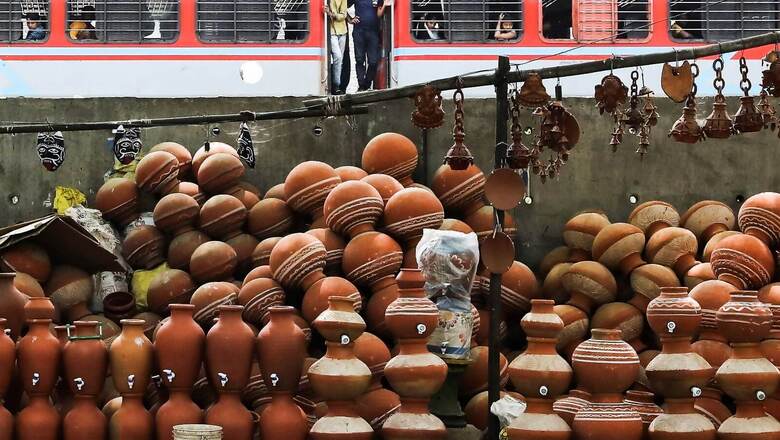
views
Heatwave in India, Weather Updates: The blistering heatwave sweeping through vast swathes of the country intensified with the mercury crossing the 45-degree mark at several places. Gurugram logged an all-time high of 45.6 degrees Celsius on Thursday, breaking the previous record of 44.8 degrees Celsius on April 28, 1979.
Its neighbour Delhi saw the hottest April day in 12 years at 43.5 degrees Celsius. The national capital recorded a maximum temperature of 43.7 degrees Celsius on April 18, 2010. The intense heatwave scorched Allahabad (45.9 degrees Celsius) in Uttar Pradesh; Khajuraho (45.6 degrees Celsius), Nowgong (45.6 degrees Celsius), and Khargone (45.2 degrees Celsius) in Madhya Pradesh; Akola (45.4 degrees Celsius), Bramhapuri (45.2 degrees Celsius) and Jalgaon (45.6 degrees Celsius) in Maharashtra and Jharkhand’s Daltonganj (45.8 degrees Celsius).
Amid the heatwave, India’s peak power demand met or the highest supply in a day touched the all-time high of 204.65 GW on Thursday, even as various states flagged a coal shortage amid the heat woes. Delhi Minister Satyendar Jain said the national capital had only one day worth of coal supply left, and asked for the Centre’s assistance. Meanwhile, protests were also witnessed outside Punjab Power Minister Harbhajan Singh’s residence over power cuts in the state.
Let’s look at the top updates:
- Delhi on Friday recorded its second hottest April in 72 years with an average monthly maximum temperature of 40.2 degrees Celsius, the India Meteorological Department (IMD) said.
- All 6 Units of Dadri and 5 Units of Unchahar are running at full capacity and receiving regular coal supplies. Present stock is 1,40,000 MT and 95,000 MT respectively and import coal supplies are also in pipeline: NTPC Limited.
- As per the latest model projection, around 4th May a cyclonic circulation system will develop in Andaman Sea, it’ll be followed by low pressure by 5th May, It’s likely to further intensify. All these changes likely to cause a drop in temperature: RK Jenamani, senior scientist, IMD.
- Protests are taking place outside Punjab Power minister Harbhajan Singh’s residence against power cuts.
- Yellow warning has been issued for 3 days – April 29, April 30 and May 1 – for western Rajasthan, Punjab, Haryana, Delhi, western UP, MP, Jharkhand. From May 2 a change is taking place, said IMD senior scientist RK Jenamani, adding that western disturbance is advancing; and thunder and rain likely to take place.
- An energy crisis appears to be approaching over portions of the country as coal supplies have run out, with Haryana being the most recent state to be affected. At least six hours of power were lost in Gurugram, Haryana, after the city’s electrical demand reached 9,000 megawatts (MV) and the supply fell short by 1,500 MW. The overall power loss lasted four to six hours until Thursday evening, according to Dakshin Haryana Bijli Vitran Nigam (DHBVN). The power outages ranged from 15 minutes to nearly an hour at various times of the day, and Gurugram is sure to have further outages on Friday and in the coming days. According to a Hindustan Times report, Haryana Power Generation Corporation Limited said on Thursday that the state’s average electricity demand is over 7,000 MW. In the wake of news that thermal power plants’ coal inventories are depleting, Haryana announced that it will source more power from states such as Chhattisgarh and Madhya Pradesh, as well as other sources, to meet demand, a report by India.com said.
- Delhi Minister Satyendar Jain warned of coal shortage in the national capital, saying there was only 1 day worth of coal stock left. He said the Delhi government had requested the Centre for more coal, and that ‘better coordination’ between Centre and states was needed to solve the crisis. He also said there was no payment pending from Delhi.
- The India Meteorological Department (IMD) said the spell of heatwave will persist over northwest and central India for the next four days and over east India for the next two days. “A rise of about two degrees Celsius in the maximum temperature (is) very likely over most parts of northwest India during the next two days,” it said.
- An orange alert has been issued for Rajasthan, Madhya Pradesh, and the Vidarbha region of Maharashtra for the next four days. The IMD uses four colour codes for weather warnings. Green means no action needed, yellow refers to watch and stay updated, orange means be prepared while red alert means take action. According to weather experts, temperatures may even leap to 47 degrees Celsius in parts of northwest India. “A maximum temperature of 45 degrees Celsius is normal at places like Rajasthan’s Churu, Barmer, Bikaner, and Sri Ganganagar, but 45-46 degrees Celsius in the plains of north India by April-end is quite unusual,” independent meteorologist Navdeep Dahiya said.
- The IMD said the heatwave could lead to “moderate” health concerns for vulnerable people such as infants, the elderly and people with chronic diseases. “Hence people should avoid heat exposure, wear lightweight and light-coloured cotton clothes and cover the head with a hat or umbrella,” it said. There is an increased likelihood of symptoms of heat illness in people who are either exposed to the sun for a prolonged period or doing heavy work, an IMD advisory read.
- A heatwave is declared when the maximum temperature is over 40 degrees Celsius and at least 4.5 notches above normal. A severe heatwave is declared if the departure from normal temperature is more than 6.4 notches, according to the IMD. Based on absolute recorded temperatures, a heatwave is declared when an area logs a maximum temperature of 45 degrees Celsius. A severe heatwave is declared if the maximum temperature crosses the 47-degree mark.
- Dileep Mavalankar, the director of the Indian Institute of Public Health Gandhinagar (IIPHG), said, “People need to watch out for IMD advisories, stay indoors, keep themselves hydrated and rush to the nearest health centre if they feel moderate signs of heat-related illness.” “There’s a special need to monitor the old and vulnerable just like we did during the COVID-19 waves as they can develop heat strokes even when sitting at home,” he said. Mavalankar said that cities should monitor all-cause mortality data daily along with that of hospital admissions and ambulance calls to compare it with the last five years of data to get a real indication of heat stress on mortality. Early heatwaves have a higher rate of mortality since adaptation and preparedness is low during March and April, he said.
- Large parts of India have been recording higher than normal temperatures since the last week of March, with weather experts attributing it to the absence of periodic light rainfall and thundershowers, typical for this time of the year, due to the lack of active western disturbances. Northwest India saw at least four western disturbances in March and April, but they were not strong enough to cause a significant change in weather, said Mahesh Palawat, Vice President (Meteorology and Climate Change), Skymet, a private weather forecasting agency.
- The region did not see any significant pre-monsoon activity from March 1 to April 20 which compounded the severity of successive heatwave spells, he said, adding it had a ripple effect on central India, too. Vidarbha in Maharashtra and west Rajasthan have consistently reported maximum temperatures in the range of 40 degrees Celsius to 45 degrees Celsius for the past two months. India saw its warmest March since the IMD began keeping records 122 years ago amid a 71 per cent rain deficit. Having recorded three prolonged heatwave spells, it could be one of the hottest April in the history of the country, Dahiya said.
With PTI inputs
Read all the Latest India News here














Comments
0 comment